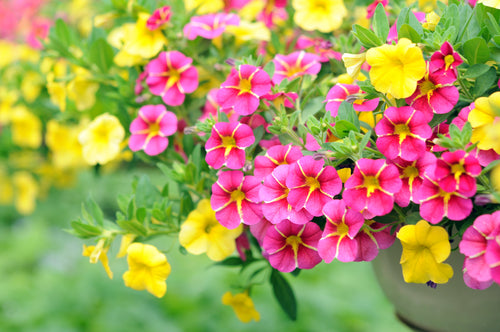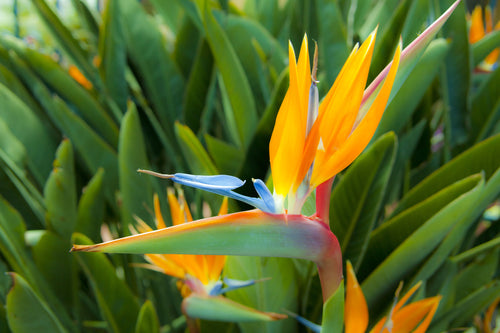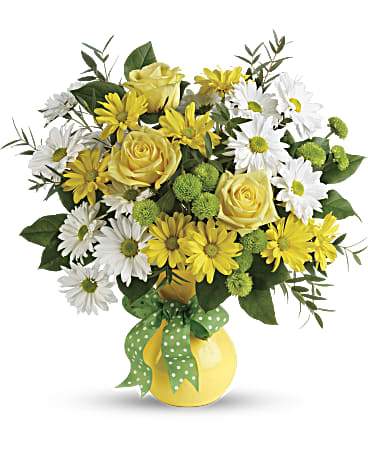Uugghh! Bugs!
Did you have your houseplants outside this summer?
Did you bring any new plants home?
Did you re–pot any plants recently?
This cold winter our customers are bringing in an abundance of houseplant leaf samples with various insect problems. Homes that lack humidity create favorable environments for insects like spider mites. Inspect your houseplants for insects! Check your plants over with a magnifying glass. Thoroughly look over the undersides of leaves and branch axils.
Before using a pesticide read all directions and precautions on the label. Because a curative is listed as organic/natural, directions and precautions still must be adhered to! Carefully read a label’s list of ingredients! A case point is two pesticides with similar spelling and pronunciation. Permethrin is a synthetic chemical found in a variety of products listed for home and garden use. Depending on the concentration, Permethrin can have a residual of up to four weeks. Pyrethrin is an organic- botanical pesticide made form extracts of pyrethrum daisies. Pyrethrin kills on contact and has no residuals. NOTE: Both pesticides have precautionary warnings on their labels.
Symptom: Plants leaves become yellow and dirty looking, then eventually dry up and drop. Fine webbing may be visible under leaves.
Diagnosis: Spider Mites – Tetranychidae
Cure: Here’s a trick to detect spider mites: Place a white piece of paper or a plate under a branch and give it a sharp tap. The mites will be easy to detect; they’re about the size of a pin head and usually red. Give the plant a shower; sponge off the leaves and rinse thoroughly. Spider mites breed best in dry environments. Increase the humidity around your plants with a misting humidifier or a vaporizer. Setting the plants in a saucer filled with gravel and water will also help.
Organic/Natural Treatment: Spray the plant with instecticidal soap, Bonide’s Bon Neem (made from Neen tree seeds), or Indoor Pharm (made from plant oils) Repeat treatment every 7 to 10 days. Inspect the plant weekly!
Conventional Treatment: Take the plants out to the garage or if possible outside and spray with Green Thumb Flying Insect Killer (with Permethrin) or Ortho’s Orthonex. Return the plants inside. Repeat treatments per label instructions.
Symptom: Cottony, oval white insects usually found on leaf axils. A shiny, sticky film may be found on leaves; black mold may grow on this film.
Diagnosis: Mealy Bugs – Coccusheporidum
Cure: Isolate infected plant; these pests are hard to get rid of! Mealy bugs feed on the sap of the plant and excrete the excess. This sticky film is called honeydew; molds can grow on its surface. Dip a toothbrush or cotton swap in rubbing alcohol and clean off as many pests as possible.
Organic/Natural Treatment: Spray the plant thoroughly with insecticidal soap or Houseplant Pharm, repeat in 7 days. Maintain inspections weekly!
Conventional Treatment: First treat the soil with Bonide’s Houseplant systemic granules. Again, take the plant out to an attached garage no colder than 45 degrees and spray with Orthonex (product contains both insecticide and fungicide). Bring the plant back in and isolate it from other plants. Repeat treatment in 10 days. Note: If you can’t spray the plant out in the garage use the systemic granules and spray with Organic/Natural treatments listed above. Remember these critters are hard to control so maintain weekly inspections. Don’t bring the plants out of isolation till the problem is cured. Unfortunately with severe infestations the plant may have to be disposed of; keeping up with inspections is key to avoiding this situation!
Symptom: Leaves and stems are covered with small, oval shaped pimples that squash easily. Honey dew may coat the leaves (see Mealy Bugs). Plant lacks vigor, eventually dropping leaves.
Diagnosis: Scale Insects – Coccus hesperidum
Cure: Eggs and immature scale (Crawlers) hide underneath their mothers shell. Clean of as many pests as possible with a sponge or brush using a solution of 1 tablespoon of dish soap with I cup of warm water; rinse thoroughly.
Organic/Natural Treatment: Use Bonide’s All Seasons Oil on plants that can tolerate horticultural oils. Spray with insecticidal soap or Indoor Pharm.
Conventional Treatment: Treat the soil with Bonide’s Houseplant Systemic Granules. Spray the plants with Bonide’s Eight ready to use (contains water–based Permethrin) or Orthonex (see Mealy Bugs).
Symptom: Leaves turn a molted yellow, cure and drop. Small white insects flutter rapidly around plants. White specs resembling dandruff are found on the undersides of leaves. Honeydew may coat the leaves and stems.
Diagnosis: Whiteflies – Aleyrodidae (Homoptera)
Cure: Your houseplants that you had outside during the summer often harbor Whitefly eggs in the soil, which hatch in late winter months inside. When watering plants outside set the nozzle to a stream and spray the undersides of the leaves up and away from the plant. Whiteflies are soft bodied, this will eliminate some and the remainder along with the eggs will be blown into the lawn. Ants and other insects will clean up after you!
Organic/Natural Treatment: Set out sticky traps. These traps are a good idea to monitor pest problems early! Spray the plants with insecticidal soap, Bonide’s Bon Neem, or Bonide’s Pyrethrin with Rootone. Whiteflies can hatch every 3 days! Repeat treatments per instructions.
Conventional Treatment: Treat the soil with Houseplant Systemic Granule’s. Spray with Eight ready to use, or Orthonex. (see Mealy Bugs for spraying advice) Repeat as necessary.
Symptoms: Small flies (resembling fruit flies) slowly buzzing around areas near your houseplants and often in your washrooms. Their larval, little worms about 1/8 of an inch resembling grubs with white bodies and black heads move in the potting soil near the stems.
Diagnosis: Fungus Gnats – Bradysia
Cure: Poor quality potting soil or soil left open outside can harbor these pests.
Fungus gnats flourish in moist damp areas, their nickname is sewer fly. Let the top 1/3 of the plants soil dry before re–watering. Make sure to empty the saucer. Spraying these gnats in flight with pesticide is not practical and should be avoided for safety purposes. Set up some sticky traps around your plants.
A bowl of soapy water made from fragrant bath soap will also act as a trap.
If gnats appear in your bathrooms spray bleach or bathroom cleaner into sink and bathtubs overflows. Plug up the holes with a rag to prevent escape.
Remember the nickname ‘Sewer Fly’, the overflows make a perfect breeding place. This problem may occur months after the pests are gone from your houseplant area!
Organic/Natural Treatment: Re-potting may be helpful but some larvae may be entwined in the clump of soil around the roots. Be careful not to remove soil from the roots, this may damage the plant! Use fresh potting soil and clean the container with 1 part bleach to 8 parts hot water. After re-potting, water the plant then liberally apply Diatomaceous Earth to the top of pot’s soil and seal with Saran Wrap (reapply after watering). The gnats and larvae will get cut up and dehydrate after contact with the Diatomaceous Earth.
Dispose of the larvae using Bacillus Thuringienis Israelensis. Pour 1/2 packet of Mosquito Beater granules ( if you’re using Mosquito Dunks use 1/4 of the wafer) into gallon of warm water and shake well. In a day the granules should be dissolved and the water will be room temperature. Shake up the mixture and drench the infected plants soil. Water your plants with this mixture for 1 week.
Conventional Treatment: Treat the soil with Bonide’s Systemic Granules.
Company Links named in article:
- Bonide– www.bonide.com
- Concern– www.woodstream.com
- Ortho– www.scotts.com/smg/brand/ortho/orthoLanding.jsp
- Pharm– www.pharmsolutions.com
01/27/2018









